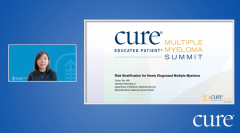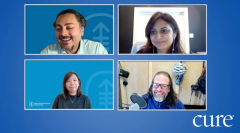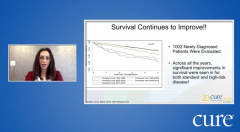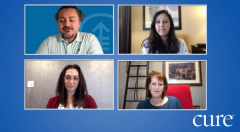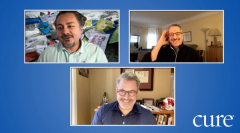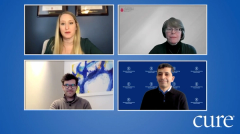
Educated Patient® Multiple Myeloma Summit Myeloma Treatment Panel: March 12, 2022
Watch Dr. Saad Z. Usmani, Dr. Krina K. Patel, Dr. Noa Biran, and Jenny Ahlstrom, answer audience Q&A during the CURE Educated Patient Multiple Myeloma Summit.
This panel featured Dr. Saad Z. Usmani, Dr. Krina K. Patel, Dr. Noa Biran, and Jenny Ahlstrom from Myeloma Crowd.
Usmani: Can you kindly discuss some of the resources available at Myeloma Crowd and Health Tree?
Ahlstrom: Sure. So when I was diagnosed, I just found some gaps that existed, like even something as basic as finding a myeloma specialist. And I know when Dr. Patel's talking, I just kept thinking of the importance of having one of you on our team, as patients that is the number one thing that I tell patients, that if they can do nothing else, the biggest resource you're going to have is to get help with a myeloma expert. So that's the first thing that patients should consider. So we built an online myeloma specialist directory that you can find on myelomacrowd.org, to help you find a myeloma specialist that it treats in your area. Some of the other things that we do is we've built two sets of things, one to educate and support the community. So other programs that do that include our myeloma coach program. So you can get help. We have over 170 myeloma coaches, and they all have different expertise. So if you're heading into transplant, like we've discussed, or if you're relapsed, or whatnot, you can have one or you get to pick your coach, so you can get one or more coaches.
We also have something called Health Tree University. And that is taught by you as experts. So we're so happy. We have over 100 myeloma specialists, as faculty on health care University, and that's a full organized curriculum. So if you've been newly diagnosed with multiple myeloma, or if you relapse, and you want to learn more, we have everything. So from what to do, when you're first diagnosed, we have newly diagnosed patients who say I binge watch my way through health tree university, because it's organized, and it's taught by faculty, and we're constantly updating it because myeloma is moving really fast. So those are some of the programs that we have on the community's education support.
We have live meetings, we have community chapters we hosted, I think we hosted like 136 webinars last year. And this year, we're going back to our live meetings. And we will have one at the end of this month at MD Anderson, and with some of these doctors, wonderful doctors, and, and others throughout the years. So and those are kind of spread out. Those are among Myeloma Crowd round tables. We mentioned health tree. So we have this hypothesis that if we could invite patients to connect their mind with stories and their data into a patient portal, we could come to conclusions faster. So we now have over 10,000 patients who have joined, which now call it the health tree care hub. And you'll see some of our names kind of shifting over to the health tree name as opposed to the Myeloma Crowd name in the future. But that is a portal where patients can gain benefit from using it even as a single member or as a group. So patients can include things like they can sign a consent, and our team, we have a team that will go in and get their information, usually from multiple facilities put in a single place. So now you can see everything, like your labs, your genetics, your prior lines of therapy, all from your health care record that's very validated and accurate. And we have a validation team that does that.
You can also find clinical trials that are personally relevant sometimes getting on clinical trials.gov is sort of a nightmare for patients because how do you sort through 450 open clinical trials and figure out the ones that you could actually join? So there's a clinical trial finder. There's also based on expert opinion, some of the myeloma doctors, we invited them to say how would you treat a newly diagnosed standard-risk patient or newly diagnosed high-risk patient or somebody that relapsed? So we can show treatment options that you can consider and take that to your doctor and have this intelligent, educated conversation about your treatment options. Because as you heard, there are a lot of treatment options. And then the last thing that Health Tree does, most importantly to me, is it helps facilitate research from you as myeloma experts.
I have heard in another session, you know about some of the diet kind of based studies that are running and like we are funding Dr. Shaw's study at MSK to do that to identify and we're using the Health Tree cure hub as a platform to do that. We're also helping investigators answer simple questions. So we have survey and study capability inside that platform. So we can invite patients.
One important question that was kind of taboo when I was diagnosed in 2010. was is there a myeloma cure? You know, like, what does that mean? What does the myeloma cure mean? And if you said that 10 years ago, you were kind of mocked and laughed, laughed away. And I never heard investigators ever say that. But now you all are talking about a potential cure for myeloma? And how do we do that for a subset of patients with what combinations? And so we asked that question for one of the investigators. And we got 1500 responses in less than four weeks. And I kind of said, how long would that have taken you to run that study. And he said, that would have taken me a year to year and a half and cost over $100,000. And we did it for free. And in four weeks, and he's off to the races, you know, publishing on that data. So that's what our goal is, is patients can contribute to be part of the cure, they've just never really been given the tools to do that. And I've talked a lot about our tools. But anyway, I'll let you ask another question.
Usmani: I think you provided an excellent summary and also gave a bit of the historic perspective. I've been a proponent for thinking about cure, or curative strategies, and I think we in about what we heard, in both of the talks from doctors, Patel, MD, Rhonda, we have so many exciting therapies and modalities that have emerged in myeloma that we can make this a reality for a subset of patients over the next five to 10 years. So, this is an exciting time to be a myeloma investigator, and then to see patients stepping up and partnering towards that goal. So thanks for everything that you do. This was an excellent summary.
Alright, so, my next question is going to go to Dr. Patel. What role, if any, does MRD testing play in managing myeloma patients? You know, if someone was MRD negative, if they're turning positive, do you change treatment? How do we interpret that?
Patel: Yes, those are fantastic questions. And hopefully, one day MRD will be able to allow us to do that. So that's why we call it a predictive marker, you know, if we can use that to say we need to change therapy. As of right now, all our data, makes it a prognostic marker, the one time. So basically, it tells me that when I see somebody go MRD negative, and they're still MRD negative, let's say one or two years after they've gone through their initial therapy, I know that their myeloma is likely going to stay in hibernation a lot longer than if they're MRD positive. The problem is … as an individual, though, do I have patients who are MRD positive, or their M protein stayed positive and never went down completely, and they're still years later doing well? Yes.
And so that's why changing therapy right now is a little bit difficult until we have more data to prove that that actually will help outcomes, because some of our patients can turn into an MGUS type thing where if I treat, I'm actually going to give them more toxicity with new therapy and more resistance faster. So I think for that reason, we don't use it to change treatment. My one group of patients where I take it a little bit more seriously are my high-risk patients. So again, our high-risk patients can go into an MRD-negative state very quickly, but then they can come right back out of it very quickly. And when their disease goes off, it can cause a lot of issues really fast. And if we wait for an M protein to get to .5, they might have kidney failure by then or they might have a new bone lesion bypass. So in those patients, I tend to just watch them very, very closely and maybe change therapy if I know their disease was really bad in the first place and I need to knock it down. So For most patients, it's a great tool to have and in the future, hopefully will help us more.
Usmani: Well put Dr. Patel and the same question for Dr. Biran. You know, and now I'll ask that same question about the role of MRD for relapsed patients, you know. So do you use that, you know, how do you use that data in patients who have relapsed myeloma?
Biran: I think it's important to understand: Who is and who is not achieving MRD negativity? And that's why I am checking it in patients who achieve what's called a biochemical remission, meaning their M spike disappears, their kappa lambda ratio is normal, I check for MRD. It's prognostic, nobody will tell you that it's not good to have absence of disease in the bone marrow. It's logic, it's common sense. We know it's good to get rid of as much disease as possible. My issue with using it to make treatment decisions is there. I don't make treatment decisions for the most part based on MRD negativity, because we know right now, myeloma is not curable in the majority of patients. So even with MRD negativity, we see relapse. There are diseases where MRD negativity means cure, like all acute leukemia-type diseases, and that's where this test really started. But I think there are some situations where patients are having trouble with toxicity, with side effects. And it may help to say, well, we're MRD negative, we can maybe scale back on some of the treatments and then repeat the MRD test and half a year or so, and use it as a longitudinal test. So it's not enough to just check it once. You have to check it continuously to see if there's a change. And other issue that we forget with MRD negativity is that myeloma is a very patchy disease. So you may do a bone marrow on the left, and it's MRD negative and then the same day, you may do it on the right side and it's MRD positive. Or you may have a patient with MRD-negative disease in the bone marrow, but they have active disease on a PET scan. So it's not you have to take these results with a grain of salt in the relapse setting especially. Yes, it's a good prognosis to have MRD negativity, but I wouldn't make substantial decisions with this test at this moment.
Usmani: All right. So mostly prognostic don't change treatment yet, wait for the clinical data that's looking at the role of escalating or de-escalating therapy. And stay tuned.
Ahlstrom: Can I make a comment about MRD testing from a patient perspective? I think sometimes, the patients need to know that this test exists. And they need to ask their physician about it. Because like we do, we asked patients in Health Tree care hub if they have had MRD testing done and about half have. And to me, that's not a good thing. I think this is becoming more important for clinical trials as a potential end point and FDA approvals and stuff. So I just think patients when you go get a bone marrow biopsy, if you're in a relapse state, it's good to get the baseline MRD test. And then after you finish your therapy to see how low that number has gone. And then even like Dr. Biran was saying, even on an ongoing basis, because it could indicate early relapse, and you could catch it there before you could catch it in the blood. And so it's just important to have that as another piece of information for myeloma patients. And I've had to ask for that test before, like, “Hey, are you going to run that on this biopsy? I'm not really keen on doing another one. So you know, can you can you run it?” Just, you know, not all I think you as experts run it all the time, but a lot of patients are being seen in the community oncology setting and may not know that, that this test is even available.
Usmani: That's an excellent point. And I think one of our key messages, you know, when we give talks is to talk about MRD testing, you know, with our community colleagues, but empowering patients with that knowledge and, you know, putting this on your to-do list or in a question to ask when you go and chat with your physician would be extremely important. Thank you for bringing that up Jenny. I completely agree with that.
Alright, so I have a couple more questions before we take a break. This question is for Dr. Patel. You know how, in fact, Dr. Biran, you can chime in as well. So how do you manage older frail myeloma patients? You know, an example is someone who's in their early 80s, with comorbidities. Because, you know, most of the data that we've generated, you know, we tried to extrapolate to that patient population. So what is your typical approach?
Patel: Yeah, that's a fantastic question. Because again, myeloma, for the most part is a disease of older folks of 69, as our average age. So you know, we see it all, but a lot of my patients are older. It really is about their comorbidities being related to the disease versus other things. So, you know, having had multiple heart attacks, or having had, you know, diabetes and high blood pressure for 40 years of your life, your kidneys aren't working as well. So if it's related to non-myeloma related issues, I tend to really use those induction therapies or even treatments with lower doses that we talked about. So RVD, I'll use lower doses of the lenalidomide first and slowly increase rather than using the full doses and have something bad happen with toxicity. And usually that approach has worked really well. I think the main part is if myeloma is causing some issues, we don't want to say that that's why that patient is frail. And we shouldn't be using the full doses of drugs. So again, it's not a one-time prescription. That's it, but every time I see them every month, every two months, we'll look. And if they're doing really well, now, their kidney function is better, I'm actually increasing those doses back up. And having said that, you know, my oldest patient to go through CAR T on a trial and a standard of care is 83. And they've both done phenomenally. So age cannot be the reason it really has to be about performance status, and sort of just how much they can do. And again, you know, with Jenny agreeing with her that a myeloma specialist can help with that, because we kind of know what's disease, what's not disease, and what our therapies can and can't do in terms of toxicity and response.
Biran: I agree with that, I think we need to look at a patient as a whole. And I think it sometimes helps to see people who are frail more frequently. So I will sometimes just bring my patient in once, twice a week, you know, to check blood check chemistries, make sure they're not getting dehydrated, if they're frail. And just, you know, I love the monoclonal antibodies and the more frail patients because they really tend to tolerate it, it's an injection, eventually, it's once monthly, there are very few, you know, cardiac side effects or pulmonary. So I like those types of therapies, and then frequent checks.
Usmani: Alright, great. One more question. How do you explain relapse in a light chain my location? You know, are you looking at light chain values, the ratio? Are you checking the urine? You know, what's your typical approach?
Biran: Thank you for asking. That question is very different, because they're not going to secrete an M spike. So I think for, you know, in our practice, we check light chains. With every set of myeloma labs, we do myeloma labs every three months and people who are in remission, just to, you know, see what the trend is. In people who have kidney problems, you have to be careful with just checking light chains because the kidneys don't clear the light chains. So, an elevated light chain may not be an indicator of progression of disease, you have to look at the difference between the cancerous and non-cancerous light chain and you have to look at the ratio. In addition, the protein in the urine is very important because light chain, myeloma can cause often kidney disease where those light chains deposit in the tubes of the kidneys and cause protein in the urine. So if you start to see foam or bubbles in your urine, that can be a sign of relapse. So I checked light chains I check 24-hour urine and very low threshold for doing bone imaging. If there's any pain that doesn't go away, that's in one spot or what we call focal pain. That's an indicator to do a bone imaging test.
Patel: Yeah, and I'll just agree. I think she said it at all. But infections other things will also make your light chains go up if you're dehydrated. So yeah, light chains are a little bit harder but to do the right tests at the right time is really important. So you don't miss something.
Raw transcriptions have been lightly edited for clarity.
For more news on cancer updates, research and education, don’t forget to

